Description, cultivation and application of Brown's Honeysuckle Dropmore Scarlet
Dropmore Scarlet's Honeysuckle is a species of Brown's honeysuckle. The culture is distinguished by spectacular bright orange or scarlet flowers. After flowering, the decorative effect of the bushes is enhanced by the red-orange fruits collected on the stalk. The plant attracts attention with luscious greenery with leaves of an unusual shape and graceful lianas, densely braiding the supports. Read more about planting and caring for Brown Dropmore Scarlet's honeysuckle.
The content of the article
Description of Brown's Honeysuckle Dropmore Scarlet
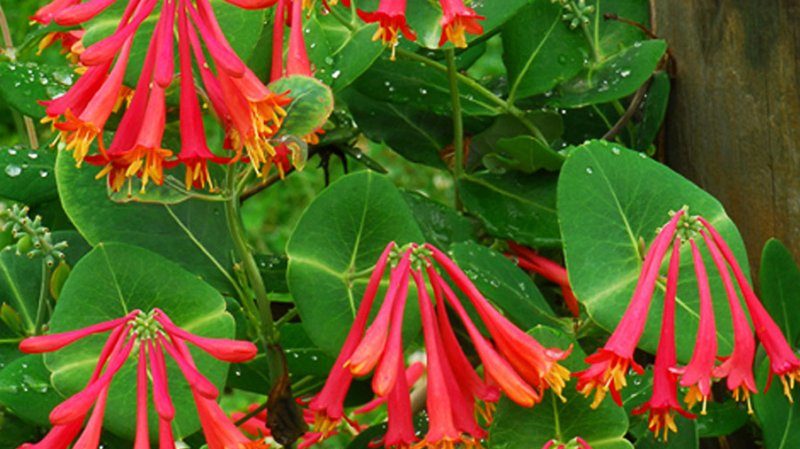
In the middle of the 19th century, breeders set up an experiment on crossing rough and evergreen honeysuckle. The result made a lasting impression. The plant bloomed for a long time, profusely and amazed with the beauty of flowers resembling fuchsia. Gardeners became interested in the plant and began to actively use it for landscaping areas. Honeysuckle got the popular name - fuchsia.
Brown's Honeysuckle Scarlet Dropmore belongs to the Brown group of hybrids... It is a hybrid of the rough Lornicera Hirsuta and the evergreen Lornicera Sempervirens. It was bred in 1950 in the Canadian province of Manitoba. The authorship belongs to the breeder Frank Skinner.
The scientific name for Brown's honeysuckle is Lonicera brownii. The plant is a semi-deciduous shrub about 2.5 m high. Young shoots are purple.
Leaves are oval, leathery, dark green in color. The back side of the leaf plate is gray. The leaves grow together in pairs at the tip of the shoot in the form of an elliptical disc. The foliage opens in the second decade of May.
Flowers are collected in 6-35 pieces in whorled clusters, have a tubular-bell-shaped shape. Flower length - 6 cm. The outer side of the petals is colored orange, red-scarlet or purplish pink, the inner side is yellow or scarlet. Abundant flowering, begins in early June - July and ends in September - October.
Fruits are inedible, spherical, red-orange in color, collected in clusters on the stalk. Bright fruits prolong the decorative effect of honeysuckle by 2-4 weeks after flowering. They contain small seeds up to 3 mm in size.
Reference. Abundant fruiting occurs in areas with long summers.
Growing features
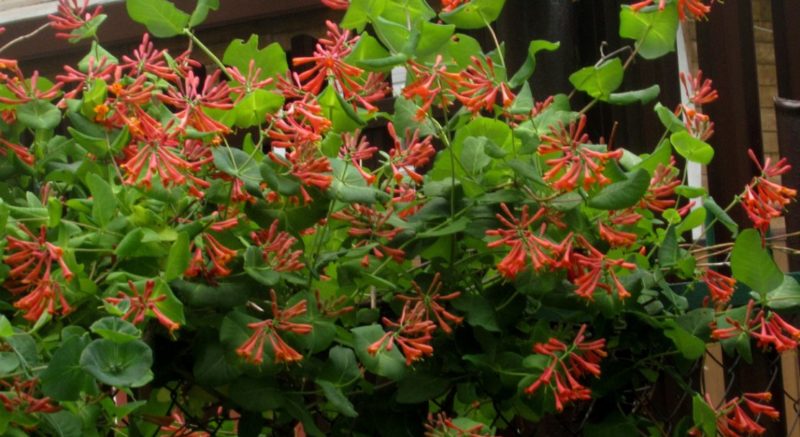
Brown's honeysuckle is hardy, hardy and easy to care for. The plant is resistant to short-term drought, spring frosts and diseases. Due to dense branching and neat crown, it takes up little space on the site. This allows summer residents of the middle lane to use Dropmore Scarlet for landscaping the local area on trellises.
Site selection and soil preparation
The plant prefers lighted areas with shading of the lower part of the bush. To do this, use mulch - tree bark, straw, sawdust. On the south side, a low fence is placed in front of the bush or meter-long flowers are densely planted.
Honeysuckle loves moisture, so it can be planted in the lowlands, where melt and rainwater accumulates. The only requirement for the soil is that it should not be swampy. The permissible acidity of the soil is pH = 3.9-7.7, the optimum is pH = 5.5-6.5. The plant prefers areas with neutral or weak soil acidity.
The soil mixture is prepared from garden soil, peat, compost and sand in equal parts (1: 1: 1: 1), although Dropmore Scarlet honeysuckle grows on any type of soil. On poor soils, the bushes are watered 1-2 times, depending on weather conditions, and top dressing is applied 3-4 times a year.
The plant does not like drafts, therefore it needs reliable protection from gusty northern winds. Honeysuckle can withstand frosts down to -27 ° C in the absence of wind.
It is interesting:
Features of planting and caring for honeysuckle in the Urals
Kamchatka honeysuckle - description and the best varieties
Ornamental curly honeysuckle - growing, reproduction and care
Landing algorithm
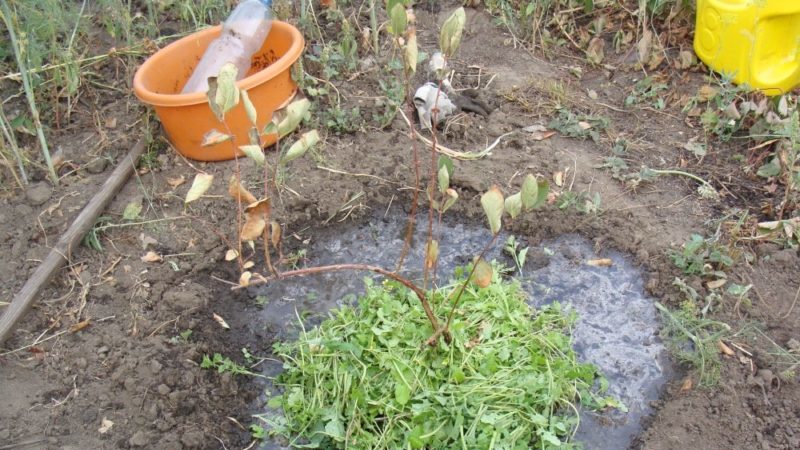
The plant is planted on the southeast or southwest side of the house. Seed propagation of Brown's honeysuckle is rarely used because of the slow result. The plant enters the flowering period 3-4 years after planting. Often the culture is propagated by cuttings or layering. Flowering occurs in the year of planting or the next.
Lignified cuttings are harvested in early spring when cutting a bush. They are cut into 20 cm pieces, leaving three buds on each. In mid-March, cuttings are planted in moist soil half the length. The moisture content of the soil is maintained constantly and does not allow excessive dryness.
Reproduction by green cuttings is carried out at the end of flowering. Choose the thickest shoots (3-5 mm) and cut into 20 cm, leaving 3-4 pairs of leaves. The distance from the bottom sheet to the cut should be 1-1.5 cm. The bottom leaves are removed, and the top ones are cut in half. Green cuttings are planted in the soil at an angle and covered with plastic bottles, having previously cut off the bottom or neck. Rooting takes 1-2 months.
Saplings are planted in the fall at the end of the growing season. Seedlings with a closed root system are planted at any time of the year, except for winter.
Landing technology:
- On the plot, holes are dug 25x25 cm in size for two-year-old seedlings and 50x50 cm for seedlings aged 5-6 years.
- 5 cm of gravel is placed on the bottom as a drainage layer.
- In a large container, sod, sand and humus are mixed in a ratio of 3: 1: 1 and the pit is partially filled with this substrate.
- A seedling is placed on top of the fertilized soil and the rest of the soil is poured so that the root collar is on the surface.
- The distance between the seedlings should be 1.5 m.
Care
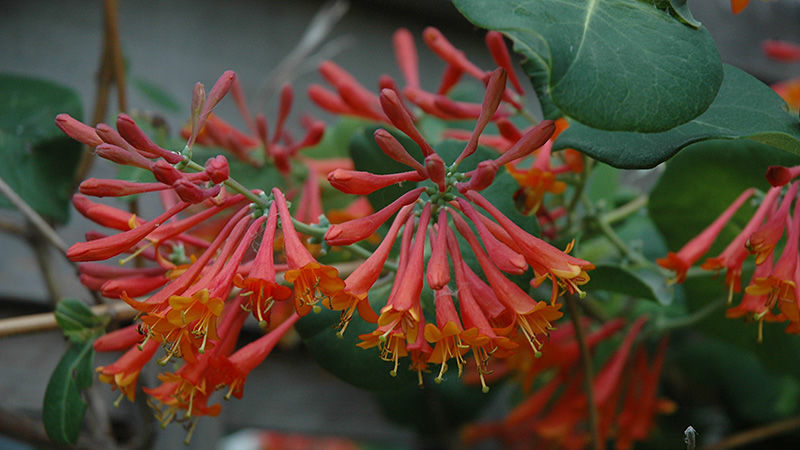
Young plants are covered with agrofibre for the winter, folded in 2-4 layers. The insulation is removed when the snow melts to prevent condensation. Also do with mature bushes when grown in regions with harsh winters.
Care rules:
- Brown's honeysuckle is watered as the soil dries and arrange sprinkling in especially hot weather. Water consumption per bush - 10 liters. Watering is carried out in the evening so that the plant receives more moisture. During the day, the water evaporates when exposed to sunlight.
- Fertilizers are applied three years after planting. From the moment of sap flow to the second decade of June, once every two weeks, the bushes are fertilized with nitrogen. Dissolve 30 g of urea in 10 liters of water and water the soil. It is not worth adding nitrogen more often - it stimulates the growth of buds and greenery and leads to thickening of the plantings. It is recommended to add 200 g of wood ash or 30 g of superphosphate to a bucket with a solution when growing a plant on sparse soils.
Dropmore Scarlet's honeysuckle is resistant to disease and insect attacks. To maintain health, it is enough to follow the rules of agricultural technology.
Pruning
In the first year of the growing season, honeysuckle needs support for crown formation. Curly vines are distributed over a hedge or trellis. After reaching the desired height, growers prune the tops, allowing the plant to grow in breadth by activating the lateral shoots.
Pruning is done in early spring or late autumn. For the first five years of growth, sanitary pruning is carried out - dry, damaged, frozen branches are removed. In the future, old shoots are cut at a level of 30-50 cm from the point of growth of dense growth.
Application in landscape design
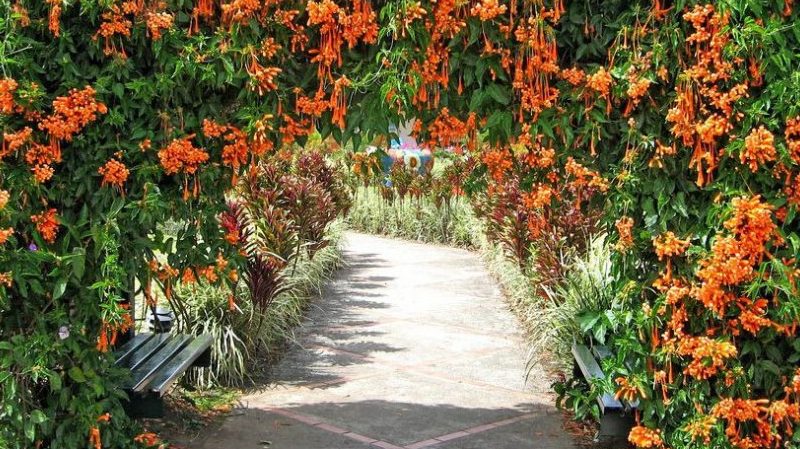
Brown's honeysuckle is used to create hedges, fences, walls of buildings. In the first year, the culture gives a slight increase, but later the vines quickly braid the supports to a height of 2-5 m.
The plant is combined with poppies, roses, peonies, cypress milkweed, coniferous shrubs. Honeysuckle is used in landscape design: it is allowed on a fence or hedge, flowering carpets are built, letting a vine on a net stretched between two posts.
Read also:
Reviews
Gardeners are delighted with the decorativeness of Dropmore Scarlet's honeysuckle, they often use it to decorate their backyards and appreciate it for its ease of care.
Irina, Bryansk: “Three years ago, my husband and I planted Brown's honeysuckle in their summer cottage. We spend the summer outside the city, so we wanted to improve the local area. I do a bit of landscaping and decided to experiment and put on a "green carpet". For planting, we used seedlings with a ready-made root system, we wanted to get a quick result. My experiment was a success - the honeysuckle bloomed the next year and grew very quickly. It blooms with amazing orange-red flowers, long and abundant. "
Pavel, Vologda: “Dropmore Scarlet's honeysuckle has been growing with us for over six years. It is so easy to care for that even I - a beginner in gardening - can handle it. I planted seedlings in the fall, and in the spring the plant bloomed. I now have a beautiful green hedge that hides an unsightly mesh fence. Every year I carry out sanitary pruning and feed with wood ash. "
Maria, Voskresensk: “Brown's honeysuckle is the ideal plant for those looking to ennoble their home grounds. It can withstand severe frosts provided it is sheltered. I use tarps and take them off in the spring. Sometimes the tips of the branches freeze slightly, but after cutting they quickly recover. The maintenance is not burdensome, it is enough to water once a week, feed with nitrogen and carry out sanitary pruning. "
Conclusion
Brown's Honeysuckle Dropmore Scarlet is an ornamental hybrid characterized by winter hardiness and easy maintenance. The plant is used in landscape design for the purpose of landscaping personal plots. Blooming liana densely wraps around the supports, creating a hedge. Bright orange or scarlet flowers make a pleasant impression and attract the attention of passers-by. Caring for the bushes is not burdensome even for novice gardeners, it is enough to water the plant on time, apply top dressing and perform pruning.